22nd EVENING-23rd EVENING 2015 BAKR-IDD_EID-UL AZHA EID-UL-ZUHA EID-AL-ADHA
Eid al-Adha
From Wikipedia, the free encyclopedia
| |
|---|---|

Blessings for Eid Al-Adha.
| |
| Observed by | Muslims and Druze |
| Type | Islamic |
| Significance |
|
| Celebrations |
Meals, especially lunches and late breakfasts (brunches)
|
| Observances |
Sacrifice of, usually, a sheep, cow, goat, buffalo or camel
Donating one-third of the sacrifice meat to friends and neighbors
Donating one-third or more of the sacrifice meat to the poor and needy
|
| Begins | 10 Dhu al-Hijjah |
| Ends | 13 Dhu al-Hijjah |
| Date | 10 Dhu al-Hijjah |
| 2014 date | 5 October |
| 2015 date | 24 September |
| 2016 date | 11 September |
| Related to | |
Eid al-Adha (Arabic: عيد الأضحى ʿīd al-aḍḥā, [ʕiːd ælˈʔɑdˤħæ]), also called the Feast of Sacrifice (Turkish: Kurban Bayramı; Malay: Hari Raya Korban; Persian: عید قربان `īd-e qorbān), the Greater Eid, or Bakr-Eid (Urdu:بقر عید baqr `īd), is the second of two religious holidays celebrated by Muslims worldwide each year. It honors the willingness of Abraham (Ibrahim) to sacrifice his son, as an act of submission to God's command, before God then intervened, through his angel Jibra'il and informs him that his sacrifice has already been accepted. The meat from the sacrificed animal is preferred to be divided into three parts. The family retains one third of the share; another third is given to relatives, friends and neighbors; and the remaining third is given to the poor and needy.
In the lunar-based Islamic calendar, Eid al-Adha falls on the 10th day of Dhu al-Hijjah and lasts for four days.[1] In the international (Gregorian) calendar, the dates vary from year to year, drifting approximately 11 days earlier each year.
Eid al-Adha is the latter of the two Eid holidays, the former being Eid al-Fitr. The basis for the observance comes from the 196th ayah (verse) of Al-Baqara, the second sura of the Quran.[2] The word "Eid" appears once in Al-Ma'ida, the fifth sura of the Quran, with the meaning "solemn festival".[3]
Like Eid al-Fitr, Eid al-Adha begins with a Sunnah prayer of two rakats followed by a sermon (khutbah). Eid al-Adha celebrations start after the descent of the Hujjaj, the pilgrims performing the Hajj, from Mount Arafat, a hill east of Mecca. Eid sacrifice may take place until sunset on the 13th day of Dhu al-Hijjah.[4] The days of Eid have been singled out in the Hadith as "days of remembrance". The takbir (days) of Tashriq are from the Fajr prayer of the 9th of Dhu al-Hijjah up to the Asr prayer of the 13th of Dhu al-Hijjah (5 days and 4 nights). This equals 23 prayers: 5 on the 9th–12th, which equals 20, and 3 on the 13th.[5]
Contents
[hide]Other names[edit]
The Arabic term "festival of the sacrifice", ʿīd al-aḍḥā/ʿīd ul-aḍḥā is borrowed into Indo-Aryan languages such as Hindi, Bengali, and Gujarati, Urdu and Austronesian languages, such asMalay and Indonesian (the last often spelling it as Aidiladha or Iduladha).[citation needed] Another Arabic word for "sacrifice" is Qurbani (Arabic: قربان), which is borrowed into Dari Persianand Standard Persian as عید قربان (Eyd-e Ghorbân), or in Urdu as قربانی کی عید (Qorbani ki Eid) Tajik Persian as Иди Қурбон (Idi Qurbon), Kazakh as Құрбан айт (Qurban ayt), Uyghur asQurban Heyit, and also into various Indo-Aryan languages such as Bengali as কোরবানির ঈদ (Korbanir Eid). Other languages combined the Arabic word qurbān with local terms for "festival", as in Kurdish (Cejna Qurbanê),[6] Pashto (د قربانۍ اختر da Qurbānəi Axtar), Turkish (Kurban Bayramı), Turkmen (Gurban Baýramy), Azeri (Qurban Bayramı), Tatar (Qorban Bäyräme), Albanian (Kurban Bajrami), Bosnian-Croatian-Serbian and Macedonian (Kurban bajram, Курбан бајрам), Russian (Курбан-байрам), Bulgarian (Курбан Байрам), Mandarin Chinese (古尔邦节 Gúěrbāng Jié), and Malaysian and Indonesian (Hari Raya Korban, Qurbani).[citation needed]
Eid al-Kabir, an Arabic term meaning "the Greater Eid" (the "Lesser Eid" being Eid al-Fitr),[7] is used in Yemen, Syria, and North Africa (Morocco, Algeria, Tunisia, Libya, and Egypt). The term was borrowed directly into French as Aïd el-Kebir. Translations of "Big Eid" or "Greater Eid" are used in Pashto (لوی اختر Loy Axtar), Kashmiri (Baed Eid),Pakistani(Baṛī Īd), Hindustani (Baṛī Īd), Tamil (Peru Nāl, "Great Day") and Malayalam (Bali Perunnal, "Great Day of Sacrifice"). Albanian, on the other hand, uses Bajram(i) i vogël or "the Lesser Eid" (as opposed toBajram i Madh, the "Greater Eid", for Eid al-Fitr) as an alternative reference to Eid al-Adha.[citation needed] Some names refer to the fact that the holiday occurs after the culmination of the annual Hajj. Such names are used in Malaysian and Indonesian (Hari Raya Haji "Hajj celebration day", Lebaran Haji, Lebaran Kaji), and Tamil (Hajji Peru Nāl).[citation needed] In Urdu- and Hindi-speaking areas, the festival is also called Bakr Īd,[8] stemming from the Hindustani word bakrī, "goat", because of the tradition of sacrificing a goat in South Asia. This term is also borrowed into other languages, such as Tamil Bakr Īd Peru Nāl.[citation needed]
Other local names include Mandarin Chinese 宰牲节 Zǎishēng Jié ("Slaughter-livestock Festival") as well as Tfaska Tamoqqart in the Berber language of Djerba, Tabaski or Tobaski inWolof,[9][10] Babbar Sallah in Hausa language, Pagdiriwang ng Sakripisyo in Filipino and ciida gawraca in Somali.[citation needed] Eid al-Adha has had other names outside the Muslim world. The name is often simply translated into the local language, such as English Feast of the Sacrifice, German Opferfest, Dutch Offerfeest, Romanian Sărbătoarea Sacrificiului, and Hungarian Áldozati ünnep. In Spanish it is known as Fiesta del Cordero ("festival of the lamb").[citation needed]
Origin[edit]
|
|---|
 |
According to Islamic tradition, the valley of Mecca (in present-day Saudi Arabia) was a dry, rocky and uninhabited place. God instructed Abraham to bring Hagar (Hājar), his Arabian (Adnan) wife, and Ishmael to theArabia from the land of Canaan. As Abraham was preparing for his return journey back to Canaan, Hagar asked him, "Did God order you to leave us here? Or are you leaving us here to die." Abraham didn't even look back. He just nodded, afraid that he would be too sad and that he would disobey God. Hagar said, "Then God will not waste us; you can go". Though Abraham had left a large quantity of food and water with Hagar and Ishmael, the supplies quickly ran out, and within a few days the two began to feel the pangs of hunger and dehydration.
Hagar ran up and down between two hills called Al-Safa and Al-Marwah seven times, in her desperate quest for water. Exhausted, she finally collapsed beside her baby Ishmael and prayed to God for deliverance. Miraculously, a spring of water gushed forth from the earth at the feet of baby Ishmael. Other accounts have the angel Gabriel (Jibrail) striking the earth and causing the spring to flow in abundance. With this secure water supply, known as the Zamzam Well, they were not only able to provide for their own needs, but were also able to trade water with passing nomads for food and supplies.
Years later, Abraham was instructed by God to return from Canaan to build a place of worship adjacent to Hagar's well (the Zamzam Well). Abraham and Ishmael constructed a stone and mortar structure – known as theKaaba – which was to be the gathering place for all who wished to strengthen their faith in God. As the years passed, Ishmael was blessed with prophethood (Nubuwwah) and gave the nomads of the desert his message of submission to God. After many centuries, Mecca became a thriving desert city and a major center for trade, thanks to its reliable water source, the well of Zamzam.
One of the main trials of Abraham's life was to face the command of God to sacrifice his dearest possession, his son. The son is not named in the Quran, but most modern Muslims believe it to be Ishmael. Upon hearing this command, he prepared to submit to God's will. During this preparation, Satan (Shaitan) tempted Abraham and his family by trying to dissuade them from carrying out God's commandment, and Abraham drove Satan away by throwing pebbles at him. In commemoration of their rejection of Satan, stones are thrown at symbolic pillars signifying Satan during the Hajj rites.
When Abraham was 99, God decided to test his faith in public. Abraham had a recurring dream, in which God commanded him to offer up for sacrifice – his son, whom God had granted him after many years of deep prayer. Abraham knew that the dreams of the prophets were divinely inspired, and one of the ways in which God communicated with his prophets. When the intent of the dreams became clear to him, Abraham decided to fulfill God's command and offer his son for sacrifice.
Although Abraham was ready to sacrifice his dearest for God's sake, he could not just bring his son to the place of sacrifice without his consent. His son had to be consulted as to whether he was willing to give up his life in fulfillment of God's command. This consultation would be a major test of his son's maturity in faith; love and commitment for God; willingness to obey his father; and readiness to sacrifice his own life for the sake of God.
Abraham presented the matter to his son and asked for his opinion about the dreams of slaughtering him. His child did not show any hesitation or reservation even for a moment. He said, "Father, do what you have been commanded. You will find me, Insha'Allah(God willing), to be very patient." His mature response, his deep insight into the nature of his father’s dreams, his commitment to God, and ultimately his willingness to sacrifice his own life for the sake of God were all unprecedented.
When Abraham attempted to cut his throat, he was astonished to see that his son was unharmed and instead, he found a dead ram which was slaughtered. Abraham had passed the test by his willingness to carry out God's command.[11][12]
This is mentioned in the Quran as follows:
Abraham had shown that his love for God superseded all others: that he would lay down his own life or the lives of those dearest to him in submission to God's command. Muslims commemorate this ultimate act of sacrifice every year during Eid al-Adha.
Eid prayers[edit]
Main article: Eid prayers
Muslims go to the mosque to pray the prayer of the Eid.
Who must attend[edit]
- Men should go to mosque—or a Eidgah (a field where eid prayer held)—to perform eid prayer; Salat al-Eid is Wajib according to Hanafi and Shia (Ja'fari) scholars, Sunnah al-Mu'kkadah according to Maliki and Shafi'i jurisprudence. Women are also highly encouraged to attend, although it is not compulsory. Menstruating women do not participate in the formal prayer, but should be present to witness the goodness and the gathering of the Muslims.[15]
- Residents, which excludes travellers.
- Those in good health.
When is it performed[edit]
The Eid al-Adha prayer is performed any time after the sun completely rises up to just before the entering of Zuhr time, on the 10th of Dhu al-Hijjah. In the event of a force majeure (e.g. natural disaster), the prayer may be delayed to the 11th of Dhu al-Hijjah and then to the 12th of Dhu al-Hijjah.
The Sunnah of preparation[edit]
In keeping with the tradition of Muhammad, Muslims are encouraged to prepare themselves for the occasion of Eid. Below is a list of things Muslims are recommended to do in preparation for the Eid al-Adha festival:
- Make wudhu (ablution) and offer Salat al-Fajr (the pre-sunrise prayer).
- Prepare for personal cleanliness—take care of details of clothing, etc.
- Dress up, putting on new or best clothes available.
Rituals of the Eid prayers[edit]
The scholars differed concerning the ruling on Eid prayers. There are three scholarly points of view:
- That Eid prayer is Sunnah mu’akkadah (recommended). This is the view of Malik ibn Anas and Al-Shafi‘i.
- That it is a Fard Kifaya (communal obligation). This is the view of Abū Ḥanīfa.
- That it is Wajib on all Muslim men (a duty for each Muslim and is obligatory for men); those who do not do it with no excuse are considered sinners. This is the view of Ahmad ibn Hanbal, and was also narrated from Abū Ḥanīfa.
Eid prayers must be offered in congregation. It consists of two rakats (units) with seven Takbirs in the first Raka'ah and five Takbirs in the second Raka'ah. For Sunni Muslims, Salat al-Eid differs from the five daily canonical prayers in that no adhan (call to prayer) oriqama (call) is pronounced for the two Eid prayers.[16][17] The salat (prayer) is then followed by the khutbah, or sermon, by the Imam.
At the conclusion of the prayers and sermon, Muslims embrace and exchange greetings with one other (Eid Mubarak), give gifts (Eidi) to children, and visit one another. Many Muslims also take this opportunity to invite their non-Muslim friends, neighbours, co-workers and classmates to their Eid festivities to better acquaint them about Islam and Muslim culture.[18]
The Takbir and other rituals[edit]
The Takbir is recited from the dawn of the ninth of Dhu al-Hijjah to the thirteenth, and consists of:[19]
Allāhu akbar, Allāhu akbar الله أكبر الله أكبر lā ilāha illā Allāh لا إله إلا الله Allāhu akbar, Allāhu akbar الله أكبر الله أكبر wa li-illāhil-hamd ولله الحمد
- God is the Greatest, God is the Greatest,
- There is no deity but God
- God is the Greatest, God is the Greatest
- and to God goes all praise
Multiple variations of this recitation exist across the Muslim world
Traditions and practices[edit]
See also: Eid cuisine and Eidi (gift)
Men, women and children are expected to dress in their finest clothing to perform Eid prayer in a large congregation in an open waqf ("stopping") field called Eidgah or mosque. Affluent Muslims who can afford to, i.e. Malik-e-Nisaab, sacrifice their best halal domestic animals (usually a cow, but can also be a camel, goat, sheep or ram depending on the region) as a symbol of Abraham's willingness to sacrifice his only son. The sacrificed animals, called aḍḥiya (Arabic: أضحية, also known by its Persian term, Qurbāni), have to meet certain age and quality standards or else the animal is considered an unacceptable sacrifice. This tradition accounts for the slaughter of more than 100 million animals in only two days of Eid. In Pakistan alone nearly 10 million animals are slaughtered on Eid days costing over US$3 billion.[20]
The meat from the sacrificed animal is preferred to be divided into three parts. The family retains one third of the share; another third is given to relatives, friends and neighbors; and the remaining third is given to the poor and needy. Though the division is purely optional wherein either all the meat may be kept with oneself or may be given away to poor or needy, the preferred method as per sunnah of Muhammad is dividing it in three parts.
The regular charitable practices of the Muslim community are demonstrated during Eid al-Adha by concerted efforts to see that no impoverished person is left without an opportunity to partake in the sacrificial meal during these days. Hajj is also performed in Saudi Arabia before Eid ul Adha and millions of Muslims perform Hajj. On the event of Hajj lots of Muslims slaughter animals and divide major part of the meat in the poor people.[21]
During Eid al-Adha, distributing meat amongst the people, chanting the Takbir out loud before the Eid prayers on the first day and after prayers throughout the four days of Eid, are considered essential parts of this important Islamic festival. In some countries, families that do not own livestock can make a contribution to a charity that will provide meat to those who are in need.
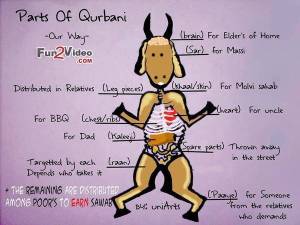
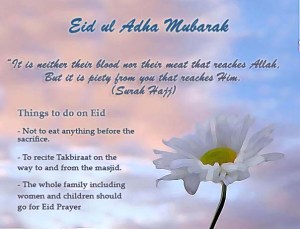
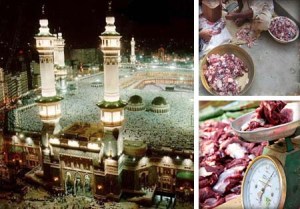
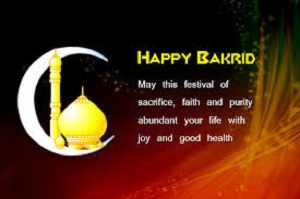
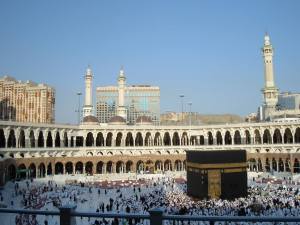







Bakri Live @ Legend 54 - YouTube
www.youtube.com/watch?v=TUtMyItfzF8
May 24, 2011 - Ormabantu vi porta nella savana: durante il cammino incontriamo Bakrie il suo vecchio balafon. Un misto di atmosfere e un sound divertente ...Goat qurbani during Bakri-Id in Delhi - YouTube
www.youtube.com/watch?v=_6meoOPb-no
Oct 5, 2012 - Uploaded by WildFilmsIndia
Walking through the bylanes of Old Delhi, one comes across pedestrians and a motorcyclist, and then... a trail of ...Tethering goats before killing it on Bakri-Id - YouTube
www.youtube.com/watch?v=cVlo-gx5-3o
Oct 6, 2012 - Uploaded by WildFilmsIndia
Walking through the bylanes of Old Delhi, one comes across pedestrians and a motorcyclist, and then... a trail of ...After Meat Ban, Controversy in Rajasthan Over Government ...
www.ndtv.com › All India
Sep 14, 2015
The day coincides with the Muslim festival of Bakr-Id, which is a holiday, but will not be this time. The ...Bakri Id/Eid ul-Adha ( Bakrid ), bakra eid qurbani in Salem ...
www.youtube.com/watch?v=yG7AvN8RG6s
Oct 24, 2012 - Uploaded by RAJUKHAN SR RAJESH
Bakri Id/Eid ul-Adha ( Bakrid ), bakra eid qurbani in Salem ... Camel Qurbani Expert Pathan in ...Qurbani or slitting off the head of goat on Bakri-Id - YouTube
www.youtube.com/watch?v=o0L_3UJdfyw
Oct 5, 2012 - Uploaded by WildFilmsIndia
Walking through the bylanes of Old Delhi, one comes across pedestrians and a motorcyclist, and then... a trail of ...BAKRA FOR SALE BAKRI ID PART-1 - YouTube
www.youtube.com/watch?v=DGkZpntSWcU
Nov 14, 2008 - Uploaded by admain
Bakra for Sale Speciality is that God Name's ALLAH, MOHAMMED is Written on Both Side of his Body ...Eid Al-Adha 2015 India: Confirmed state-wise dates for Bakr ...
www.ibtimes.co.in › Technology › Smartphones
3 days ago
Eid Al-Adha 2015 will be celebrated this week on 25 September in India, but there are some states that will ...bakrid qurbani - YouTube
www.youtube.com/watch?v=4Z2_dsZhWRI
Oct 14, 2011 - Uploaded by Bull Master
Goats brought for Eid Ul Adha Bakrid in 2014 In Hyderabad ... Bakra Eid ~ Chootia Se Bakray Ki Qurbani | Cow ...Goat's last supper before qurbani on Bakri-Id, Delhi - YouTube
www.youtube.com/watch?v=2G0tbCBoSsU
Oct 5, 2012 - Uploaded by WildFilmsIndia
Walking through the bylanes of Old Delhi, one comes across pedestrians and a motorcyclist, and then... a trail of ...
Stay up to date on results for bakri id legend.
Create alertEid al-Adha in the Gregorian calendar[edit]
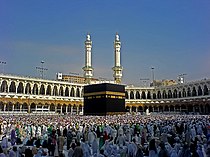 |
| Part of a series on |
| Islamic culture |
|---|
| Architecture |
| Art |
| Dress |
| Holidays |
| Literature |
| Music |
| Theatre |
See also: Islamic calendar
While Eid al-Adha is always on the same day of the Islamic calendar, the date on the Gregorian calendar varies from year to year since the Islamic calendar is a lunar calendar and the Gregorian calendar is a solar calendar. The lunar calendar is approximately eleven days shorter than the solar calendar. Each year, Eid al-Adha (like other Islamic holidays) falls on one of about 2–4 different Gregorian dates in different parts of the world, because the boundary of crescent visibility is different from the International Date Line.
The following list shows the official dates of Eid al-Adha for Saudi Arabia as announced by the Supreme Judicial Council. Future dates are estimated according to the Umm al-Qura calendar of Saudi Arabia.[22] However, it should be noted that the Umm al-Qura is just a guide for planning purposes and not the absolute determinant or fixer of dates. Confirmations of actual dates by moon sighting are applied to announce the specific dates for both Hajj rituals and the subsequent Eid festival. The three days after the listed date are also part of the festival. The time before the listed date the pilgrims visit the Mount Arafat and descend from it after sunrise of the listed day.
Future dates of Eid al-Adha might face correction 10 days before the festivity, in case of deviant lunar sighting in Saudi Arabia and Pakistan for the start of the month Dhu al-Hijjah. In many countries, the start of any lunar Hijri month varies based on the observation of new moon by local religious authorities, so the exact day of celebration varies by locality.
| Year | Date in Saudi Arabia | Date in India/Pakistan[citation needed] |
|---|---|---|
| 1418 (Islamic Calendar) | 7 April 1998 | 8 April 1998 |
| 1419 (Islamic Calendar) | 27 March 1999 | 28 March 1999 |
| 1420 (Islamic Calendar) | 16 March 2000 | 17 March 2000 |
| 1421 (Islamic Calendar) | 5 March 2001 | 6 March 2001 |
| 1422 (Islamic Calendar) | 23 February 2002 | 24 February 2002 |
| 1423 (Islamic Calendar) | 12 February 2003 | 13 February 2003 |
| 1424 (Islamic Calendar) | 1 February 2004 | 2 February 2004 |
| 1425 (Islamic Calendar) | 21 January 2005 | 22 January 2005 |
| 1426 (Islamic Calendar) | 10 January 2006 | 11 January 2006 |
| 1427 (Islamic Calendar) | 31 December 2006 | 1 January 2007 |
| 1428 (Islamic Calendar) | 20 December 2007 | 21 December 2007 |
| 1429 (Islamic Calendar) | 8 December 2008 | 9 December 2008 |
| 1430 (Islamic Calendar) | 27 November 2009 | 28 November 2009 |
| 1431 (Islamic Calendar) | 16 November 2010 | 17 November 2010 |
| 1432 (Islamic Calendar) | 6 November 2011 | 7 November 2011 |
| 1433 (Islamic Calendar) | 26 October 2012 | 27 October 2012 |
| 1434 (Islamic Calendar) | 15 October 2013 | 16 October 2013 |
| 1435 (Islamic Calendar) | 4 October 2014 | 6 October 2014 |
| 1436 (Islamic Calendar) | 24 September 2015 | 25 September 2015 |
| 1437 (Islamic Calendar) | 11 September 2016 (calculated) | 12 September 2016 (calculated) |
| 1438 (Islamic Calendar) | 1 September 2017 (calculated) | 2 September 2017 (calculated) |
| 1439 (Islamic Calendar) | 23 August 2018 (calculated) | 24 August 2018 (calculated) |
| 1440 (Islamic Calendar) | 12 August 2019 (calculated) | 13 August 2019 (calculated) |
| 1441 (Islamic Calendar) | 31 July 2020 (calculated) | 1 August 2020 (calculated) |
| 1442 (Islamic Calendar) | 20 July 2021 (calculated) | 21 July 2021 (calculated) |
| 1443 (Islamic Calendar) | 10 July 2022 (calculated) | 9 July 2022 (calculated) |
See also[edit]
Notes[edit]
^a The son is not named in the Quran, but most modern Muslims adhere to the view that it was Ismail (Ishmael). Sayings attributed to Muhammad and Islamic commentaries differ on whether Abraham's older son Ishmael, or his younger son, Ishaq, was asked to be sacrificed in the vision. A chain of narration from Yunnus b. Abd al-Ala attributed to Abdallah b. Abbas: ...The Prophet in a conversation in which he said, "Then we ransomed him with a tremendous victim." And he also said, "He is Isaac." [23] The Sunni commentary Tafsir Ibn Kathir: Ibn Jarir narrated that Ibn 'Abbas said, "The one who was ransomed was Ismail, peace be upon him. The Jews claimed that it was Ishaq, but the Jews lied. [24]


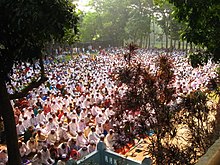







No comments:
Post a Comment